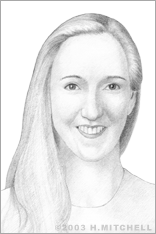Eliza Minden
There is room for technological improvement in all types of fields, including the arts. In 1993, Eliza Gaynor Minden designed and developed the Gaynor Minden pointe shoe, which provided a more functional, durable, and comfortable shoe for ballerinas around the world.
Minden was born in Boston, Massachusetts in 1959. She grew up in Southport, Connecticut, where she was encouraged to dance by her mother, a Royal Academy of Dancing teacher who founded the Connecticut Ballet Theatre School. Her sister is also a professional dancer. Minden studied ballet throughout her youth and eventually earned a BA from Yale University. Through her experience and that of her dancing friends and family, she became keenly aware of the constant soreness that pointe shoe wearers were used to suffering.
Later, Minden worked in management for dance companies, and she found that traditional pointe shoes, which typically last through only one performance, were a source of great financial frustration for these organizations. These companies, many of which are non-profit, would be forced to buy new shoes regularly for each dancer, adding thousands of dollars to their overhead. Minden, an athlete with experience in sailing, windsurfing, and skiing, knew that many modern materials had been incorporated into equipment for these sports – why not for ballet as well? She began working on designs for a new type of pointe shoe by incorporating advanced materials. She was able to draw on knowledge of product development and manufacturing that she had acquired through her family’s energy-efficient lighting business.
The project became more complex than she had anticipated. She created hundreds of prototypes, testing them on different floor surfaces, in various climates, and with dancers of different shapes, sizes, and ability. She also sought the advice of medical experts with specialization in treating dancers. She did as much as she could with her own hands, but when she needed a molded component for the supportive part of the shoe – the shank/toe box – the idea was to replace the cardboard, leather, or burlap typically used with a more advanced plastic material called an elastomeric. This component had to be molded. A friend connected her with someone who made molds so that she was able to get a prototype mold.
To perfect the design, she modified the molded prototype parts herself and affixed various shock absorbing foams in different areas. Finally, she took what she had made, which was the inside of the shoe, to a custom shoemaker for them to wrap it in satin and put an outer sole on it. She could only afford to make a single shoe at a time. Minden spent a decade on research and development, and finally, it paid off. She earned two patents on the final design, which she introduced in April 1993. The shoes are comfortable, shock-absorbent, and last three to six times longer than other brands of pointe shoes, while maintaining the quiet and flexibility of the traditional style.
With her husband, John Minden, a former advertising executive, she formed Gaynor Minden, Inc. to produce and market the shoes. She began by going to every major dance school, dance company, and summer dance program to give lectures on the history of toe dancing, which would segue into an explanation of toe shoe construction and culminate in a sales pitch and a chance to try on samples.
Minden also took advantage of the Internet, registering dancer.com and developing an informative website for dancers, which included information about the shoes. At first, the public's response to the shoes was mixed. Some dancers instantly embraced them; others were skeptical. But today, Minden says that more and more dancers are using the shoes. “The younger generation is enthusiastic about technology and tends to feel entitled to it rather than suspicious of it,” she said. “The younger generation is far more health conscious and less willing to damage their bodies.”
Dancers who wore Gaynor Minden shoes as students are dancing at the highest level with major companies, including Gillian Murphy of the American Ballet Theatre and dancers with England's Royal Ballet.
Minden has three additional patents on other ballet-related inventions, including a patent on a "Dynamic Toe Box" liner. The box compresses when the dancer lands from a jump, making room for her foot to spread out and further absorb impact. But when she is en pointe (on tip toe), it instantly returns to its original shape to fill out the toe box and help hold her foot up off the ground. Minden also has patents on a soft dancing slipper and a dancer's backpack and a patent on another kind of soft dancing slipper as well.
Her business has expanded into dancewear, with offerings that include wool and microfibre tights, “no ordinary leotard,” and dancer accessories.


